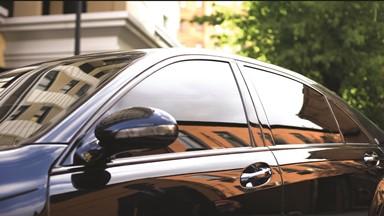
PMMA is also used in exterior trim applications.
In their quest to reduce the carbon footprint of vehicles throughout their lifecycle, OEMs are taking a critical look at all the materials that have traditionally been used in the assembly of motor vehicles.
This is leading to new applications for polymethyl methacrylate (PMMA), a synthetic resin produced from the polymerization of methyl methacrylate. It competes with glass in terms of weight and performance – PMMA grades allow 92% of light to pass through. It is also 40 to 50% lighter than glass.
Compounds suitable for use in exterior body parts and interior trim have also been developed, which helps to reduce the overall weight of the vehicle.

Automotive Industries (AI) asked , Market Development Manager at Trinseo, what challenges OEMs are facing with lighting and trim.
Hlavacek: They face the same challenges as the design of all the other components that go into a vehicle.. Changes are being driven by legislation, which is forcing OEMs to reduce their overall carbon footprint.
What we see is that lights have become more integrated into the surface of the vehicle like a dome part. Lighting has become merged into the surface, particularly in the front and rear. Over the past few years, we have seen customers acquire Tier 1/20231s in order to integrate lighting into the component. So, the Tier 1s now supply the front and rear ends with all the components already integrated. For us, the challenge is that designers are leaving smaller space for lights, but OEMs and the people who buy their cars expect the same performance and level of safety as the larger lights.
AI: How does PMMA meet those challenges and provide OEMs with more flexibility?
Hlavacek: PMMA is the right material because it provides a good combination of light performance and design. You have up to 92% light transmission. Design flexibility is important because many platforms are differentiated in part through their light signature. So, lighting is not just for safety, but for branding as well. PMMA is ideal for these applications. You need a certain level of heat resistance because the lights are getting smaller, and there is not much space for the heat to dissipate.
AI: Where do you see the applications for PMMA?
Hlavacek: We are targeting all lighting applications, both inside and on the exterior of the vehicle. Interior lighting is becoming more interactive. It can communicate with the driver to warn them that they are falling asleep or there is an obstacle in the road, for example. Or it can change color and intensity according to your route or driving status. PMMA is also used in exterior trim applications. It can be colored, which replaces painting, and reduces the complexity and cost of the process.
AI: Given the increasing operating temperatures, how do you optimize your PMMA resins for use in the LED lighting applications?
Hlavacek: Our optimization cycle involves constant interaction with the OEMs and Tiers. There are also industry forums through which common challenges regarding the sourcing of raw materials are addressed. To stay ahead we innovate constantly by improving performance, introducing new colors and properties, like better chemical resistance, and greater diffusing power. There is a constant focus on heat resistance.
AI: How are you helping OEMs to meet their sustainability goals?
Hlavacek: Sustainability is a substantial part of the Trinseo DNA. This is reflected in the dialogue we have with the OEMs and Tiers. We also closely monitor the legislative environment and the sustainability strategies at government level. We have also started developing sustainable PMMA compounds. One of the big advantages of PMMA is that it’s fully recyclable. We have developed technologies to produce grades that are made with chemically or mechanically recycled feedstock as part of the ALTUGLAS R-Life family. In 2022 we introduced several grades that are n

ow serving the cosmetics market., and we will soon broaden our portfolio to serve more markets, including automotive.
AI: What are the advantages of this for the customers and the environment?
Hlavacek: The objective is to help our customers to reduce their overall CO2 footprint. We provide sustainable solutions through providing recyclable material which can be reused. In some cases, we are working with our customers to create a closed material loop through what is known as post-industrial recycling.
Also known as “pre-consumer material,” post-industrial recycling comes from separating material from the waste stream during the manufacturing process, as defined by DIN EN ISO 14021:2016.
The automotive industry is not yet fully geared up for post-industrial recycling, but we are in close touch with some users of our materials in order to obtain high quality scrap which can be reused in various ways. For OEMs and Tiers this has the advantage of being able to manufacture components whose performance is in line that of with virgin PMMA.
It has the advantages of a reduced CO2 footprint as less energy is used in its manufacture. The process also uses less water. We are working with our customers to fine-tune the technology and recycling systems.
AI: What’s next for Trinseo?
Hlavacek: From a PMMA perspective, there is plenty of scope for development. We will be broadening our range to meet the changing needs of the auto makers. We would also like to expand geograHlavacek ically and follow our customers and partners from a global perspective.
At present Trinseo has 24 manufacturing sites globally, with11 R&D facilities. We are also looking at the localization of the feedstock because that helps reduce the carbon footprint of the logistics chain. Tools like Life Cycle Analysis (LCA) or Product Carbon Footprint (PCF) help us understand a material’s impact through its complete life cycle, from manufacturing to disposal, in order to compare it to fossil-based or other benchmarking materials.
We will continue to focus on the LCA in order to ensure sustainability and reduce our carbon footprint and that of our customers. Digitization of the processes along the entire value chain is a priority. We are working with our suppliers and customers to be able to provide the LCA data automatically and in real time. This is another way in which we are assisting our customers to reduce their carbon footprint.
There are also some exciting new products in the pipeline, which we will be launching soon. They will be suitable for extrusion and co-extrusion, and for markets outside of automotive as well.












More Stories
What to Do After a Motorcycle Accident to Protect Yourself
Injured in a Motorcycle Crash? Talk to an Attorney Now
Danisense launches ‘Online Calibration Portal’ to offer brand agnostic calibration services for current transducers and smoothen the whole process